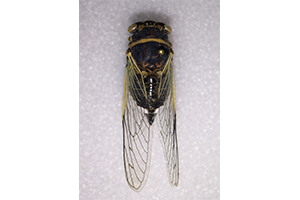Photo Credit: Peter L. Warren. Creative Commons Attribution-NonCommercial 4.0 International (CC BY-NC 4.0) License, https://creativecommons.org/licenses/by-nc/4.0/.
Diceroprocta apache
Common Name: Apache cicada
Animal Guild: Insect
Class > Order > Family: Insecta > Hemiptera > Cicadidae
Where is the species found?
States & Provinces
AZ
Which phenophases should I observe?
Do you see/hear...?
Activity
Adults More...
For abundance, enter the number of individual animals observed in this phenophase.
Adults feeding Diceroprocta apache , an adult is feeding when its piercing, sucking mouthparts are inserted in a plant.
For abundance, enter the number of individual animals observed in this phenophase.
Reproduction
Courtship calling Diceroprocta apache , these are loud buzzing sounds.
What is the intensity of calling?
Single calls: There is space between calls and individuals can be counted. Overlapping calls: Calls of individuals can be distinguished but there is some overlapping of calls. Full chorus: Calls are constant and overlapping.
Mating For abundance, enter the number of individual animals observed in this phenophase.
Recent egg laying Diceroprocta apache , females lay their eggs inside a slit they have cut in the bark of a twig or branch, after which the branch above the cut typically begins to die.
For abundance, enter the number of individual animals observed in this phenophase.
Development
Nymphs Diceroprocta apache , nymphs are similar in shape to adults, but they are brown in color and their wings are absent. They are often seen climbing trees or other structures after emerging from the ground.
For abundance, enter the number of individual animals observed in this phenophase.
Cast-off skins For abundance, enter the number of individual animals observed in this phenophase.
Dead adults For abundance, enter the number of individual animals observed in this phenophase.
Dead nymphs For abundance, enter the number of individual animals observed in this phenophase.
Method
Individuals in a trap For abundance, enter the number of individual animals observed in this phenophase.
What do these phenophases look like?
There is currently no photoguide available for this species. If you'd like help us create one, use the guidance document and species template provided here . Then send it via email to education@usanpn.org when it is complete.
